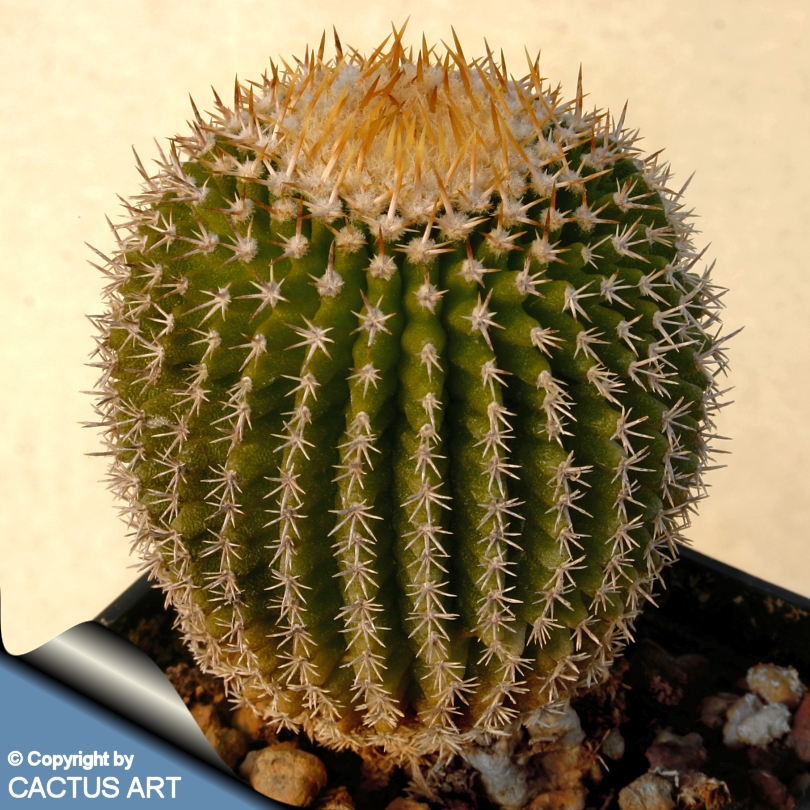|
|
|

Ubelmannia gummifera HU282 Penha de Franca, Minas Gerais, Brazil
|
|
|
Description: U. gummifera is a
globular usually solitary cactus.
Stem: Usually globular or slightly elongated in cultivation
greyish-green or reddish-green, 6-8 cm wide, 10 (or more) cm tall. (In
cultivation the colour of the plants depends on sun exposure, the plants
grown in shadow are greener , wile the ones in full sun may take a frost
brown or purple color)
Ribs: When fully mature it has about 32 to 40 prominent markedly
tuberculate ribs, but initially it has considerably fewer.
Tubercles: The tubercles protrude about 8 mm, are separated by
transverse grooves and have apical areoles.
Areoles: Close set.
Central spines: One slightly upward pointing, up to 1 cm long.
Radial spines: 3 or more, up to 5 mm long.
Flowers: Diurnal yellow. They are up to 2 cm long, 15 mm in
diameter
Blooming season: Flowers come sporadically from Early Summer to Late
Summer
Note: Uebelmannia gummifera stems have large mucilage canals
runnig along the base of the ribs, often making giant masses of
mucilage. (hence the name gummifera = gum) Because of these canals, the
ribs are not attached firmly to the rest of the plant.
|
|
Photo of conspecific taxa, varieties, forms and
cultivars of Uebelmannia gummifera.
Advertising
|
|
|
|
|
Family:
Cactaceae (Cactus
Family) |
|
|
Scientific name: Uebelmannia
gummifera (Backeb. & Voll) Buining
Tribe: Cacteae -- Subtribe:
Echinocactinae
Origin: Endemic to Brazil (mountain of Minas Gerais,
Serra de Ambrosa)
Habitat: In nature it grows grows at high altitudes in a very
acidic (pH 3.5!!!) loose quartz sand substrate, usually where
there is a very high degree of atmospheric moisture, which compensates
for the fact the soil is perfectly drained. In its natural habitat the
plant frequently grows among lichens, which may even cover it. It
also came across Pilosocereus densilinatus and
Ciphocereus crassisepalus.
Conservation status: Listed in
CITES appendix 1.
It is threatened by habitat loss.
|
|
|
|
Synonyms:
- Uebelmannia meninensis Buining,
In: Kakteen Sukk. 19: 151, fig. 1968
- Uebelmannia meninensis v. rubra P.J.Braun et
E.Esteves, 2000
- Uebelmannia gummifera (Backeberg & Voll) A.F.H.
Buining.
in: Succulenta (Netherlands) 46: 161, 1967
- Uebelmannia gummifera ssp. meninensis (A.F.H.
Buining) P.J. Braun & E. Esteves Pereira
In: Succulenta, 74 (5): 226: 1995
- Uebelmannia gummifera v. rubra (A.F.H. Buining & A.J.
Brederoo) P.J. Braun & E. Esteves Pereira,
In: Succulenta, 74 (5): 226: 1995
- Parodia gummifera Backeb. & Voll
Cultivation: Uebelmannias are very difficult to cultivate on
their own roots because they need specific growing conditions, and
are hardly ever cultivated except in very specialized collections. They
require a very acidic mineral quartz soil and cannot tolerate tap
water at all (only rain water), they need also high atmospheric humidity
(mist spraying is a must in summer) and warm temperatures all year round
( minimum 10C is best). Water regularly during the growing season and
use a very draining mineral potting substrate. At the onset of winter,
do not water. This plant prove to be root prone if kept too cold
in winter. Keep cool in summer. To help stop this a good deep collar of
pumice or lava grit is an excellent idea. It prefers a full sun position
and possibly afternoon shade in summer. If you can place it so that this
occurs the plant will be much happier.
Propagation: Seeds, but plants are often grafted making them
easier to grow, particularly through the winter. If possible using
a rootstock that is more hardy than the Uebelmannia is the ideal.


|
|